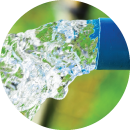
No. While chlorine dioxide has chlorine in its name, its chemistry is dramatically different from chlorine. One of the most important properties of chlorine dioxide that sets it apart from chlorine is its behaviour when placed in water. Chlorine hydrolyses, or reacts, when placed in water to form hypochlorous and hydrochloric acids. Chlorine dioxide does not hydrolyse and remains a truly dissolved gas. Chlorine dioxide has a lower oxidative potential than chlorine but has 2.5 times the capacity, making it a more effective disinfectant. Watery solutions containing approximately 1% ClO2 (10 g/L) can safely be stored, on condition that they are protected from light and heat interference.
While chlorine dioxide has chlorine in its name, its chemistry is radically different from that of chlorine. It has to do with the way electrons interact with one another. As we all learned in high school chemistry, we can mix two compounds and create a third that bears little resemblance to its parents. For instance, by mixing two parts of hydrogen gas with one of oxygen - liquid water is the formed. We should not be misled by the fact that chlorine and chlorine dioxide share a word in common. The chemistries of the two compounds are completely different.
Chlorine dioxide and chlorine - because of their fundamentally different chemistries - react in distinct ways with organic compounds, and as a result generate very different by-products. It's this difference that explains the superior environmental performance of chlorine dioxide in a number of industrial applications.
In water treatment applications, chlorine dioxide (due to its more powerful action) has broad spectrum activity over a wide range of micro-organisms, and has the ability to penetrate biofilms and other heavily contaminated areas where chlorine treatment is simply not effective. Because of its increased efficiency far less chlorine dioxide product need be used, eliminating waste and reducing handling costs and risk. Chlorine dioxide has been shown to be more powerful, easier to use, and more environmentally friendly than equivalent chlorine treatments.
| Chlorine dioxide | Chlorine |
|---|---|
| Will remove bio film and thus clean tanks and pipes. | Does not remove bio film. |
| Does not form chlorinated by-products. | Produces unwanted by-products including carcinogens. |
| Is much less corrosive than chlorine. Does not hydrolyse to form anacid. | Is corrosive and unpleasant to handle. |
| Is rapidly replacing chlorine in many countries. | Already banned in certain parts of Europe and the USA. |
| Is not pH dependent (pH 11). | Is pH dependent and very ineffective above pH 7. |
| A very broad spectrum biocide. | Is ineffective against complex organisms (e.g. cysts and protozoa). |
| Destroys phenols (without forming chlorinated phenols) specific destruction of hydrogen sulphides. Destruction of a wide range of chemical contaminants. | Limited oxidative effect against various chemical contaminants. For ms chlorinated phenols. |
| Because no unwanted by-productsare formed, and will have a lower residual after use, no neutralisation is normally required. | Neutralisation required before dumping to the foul drain. |
| Effective at higher temperatures - does not disassociate asrapidlyas chlorine. | Cannot be used at temperatures above 40 Cdue to the release of chlorine gas. |
| Cost savings in labour and use efficiency outweighs the additional chemical costs. | Increased disinfection time and more service work required to combat high bug counts. |
 Deodoriser
Deodoriser
 Sanitiser
Sanitiser
 Water purifier
Water purifier
 Biofilm remover
Biofilm remover